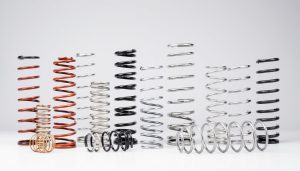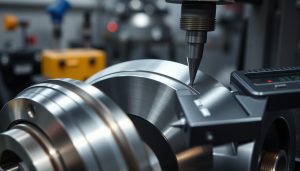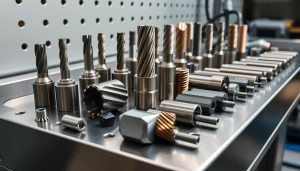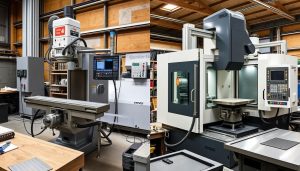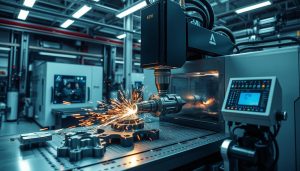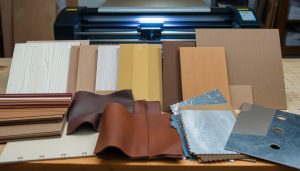In today’s fast-paced manufacturing world, die casting stands out as a key player. It’s a method that has changed how we make things. This guide will take you through the world of die casting, covering its processes, materials, and uses.
Ever curious about what makes die casting special? What benefits does it bring, and why is it so important for growth? Let’s explore these questions together and discover the magic of this metal shaping technique.
Key Takeaways
- Die casting is a highly precise and cost-effective manufacturing process for mass production.
- A wide range of materials, including aluminum, zinc, and magnesium alloys, can be used in die casting.
- Die casting is widely employed in the automotive, aerospace, and consumer electronics industries.
- Advancements in die casting technology have enabled the production of complex and intricate metal components.
- Understanding the key components and types of die casting is crucial for optimizing industrial manufacturing.
What is Die Casting?
Die casting is a way to shape metal by injecting molten metal into a mold under high pressure. It makes parts with great detail and quality. This method is often used in the automotive and aerospace fields.
Overview of the Die Casting Process
The process starts with melting the metal. Then, it’s pushed into the mold with high pressure. This makes the part smooth and detailed.
Once solid, the part is taken out of the mold. Any extra metal is then removed.
Key Components of a Die Casting System
The system has a few main parts:
- The die: A strong mold that can handle the metal’s heat and pressure.
- The injection system: It pushes the molten metal into the mold at the right speed and pressure.
- The clamping mechanism: Keeps the mold closed during the metal injection. This prevents leaks and keeps the part’s shape right.
Knowing how die casting works helps makers create many high-quality parts. It’s a key metal shaping method.
“Die casting is a game-changing metal forming process that allows for the production of complex, high-precision parts with unparalleled efficiency and cost-effectiveness.”
Types of Die Casting
Die casting is a top choice in metal casting for its efficiency and versatility. It comes in two main types: hot chamber and cold chamber die casting. Knowing the differences between these is key to picking the best method for a project.
Hot Chamber Die Casting
Hot chamber die casting, also known as gooseneck die casting, uses molten metal. This metal is often zinc alloys or aluminum alloys. It’s great for making small, detailed parts with a smooth finish.
The casting temperature is lower here, which saves energy. This makes it a cost-effective option for certain parts.
Cold Chamber Die Casting
Cold chamber die casting heats the metal in a separate chamber. Then, it’s moved to the die cavity. This method is best for bigger parts or those made from aluminum alloys with high melting points.
The die cavity isn’t heated. This allows for controlled cooling and makes it possible to create complex shapes.
Choosing between hot chamber and cold chamber die casting depends on several factors. These include the part’s size, complexity, material, and production volume. Understanding each method helps manufacturers make better choices. This leads to high-quality, affordable products.
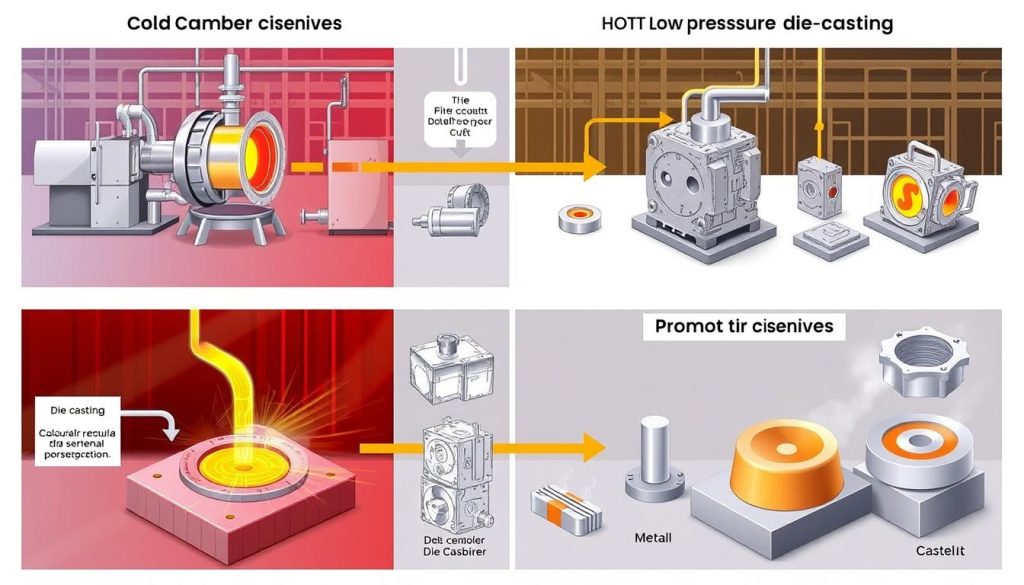
“Die casting is a versatile and efficient metal forming process that produces intricate parts with exceptional precision and a superior surface finish.”
Common Materials Used in Die Casting
Die casting is a versatile method that uses non-ferrous metals and alloys. It creates detailed and precise parts. Aluminum, zinc, and magnesium alloys are common. Each has special material properties and alloy composition for different needs.
Aluminum Alloys
Aluminum is a top pick for die casting. It’s light, resistant to corrosion, and great for heat and electricity. Alloys like AlSi10Mg and ADC12 are used in cars, planes, and gadgets. They’re chosen for their non-ferrous metals and material properties.
Zinc Alloys
Zinc alloys, like ZA-8 and ZA-12, are strong, stable, and affordable. They’re used in tools, car parts, and home items. Their ability to be cast into complex shapes is a big plus.
Magnesium Alloys
Magnesium alloys, such as AZ91D and AM60B, are strong and light. They’re great for cars and planes. Their non-ferrous metals and alloy composition make them perfect for detailed, lightweight parts.
“Die casting allows manufacturers to produce complex, precise parts from a wide range of non-ferrous metals, each with their unique material properties and alloy composition.”
Die casting’s flexibility and the variety of non-ferrous metals help manufacturers choose the right alloy composition. This meets specific product needs, like being light, resistant to corrosion, or strong. Knowing these materials’ unique traits helps designers and engineers make better parts for many uses.
Advantages of Die Casting
Die casting is a fast and efficient way to make parts. It’s great for creating complex shapes with high precision and a smooth finish. This method is both accurate and cost-effective, making it perfect for making lots of parts.
High Precision and Surface Finish
Die casting stands out for its ability to make parts with exact dimensions and a flawless surface. The mold is designed with great care, and the pressure applied during casting is consistent. This results in parts that are stable and have detailed shapes.
This precision is key for parts in industries like cars, planes, and gadgets. These parts need to fit together perfectly.
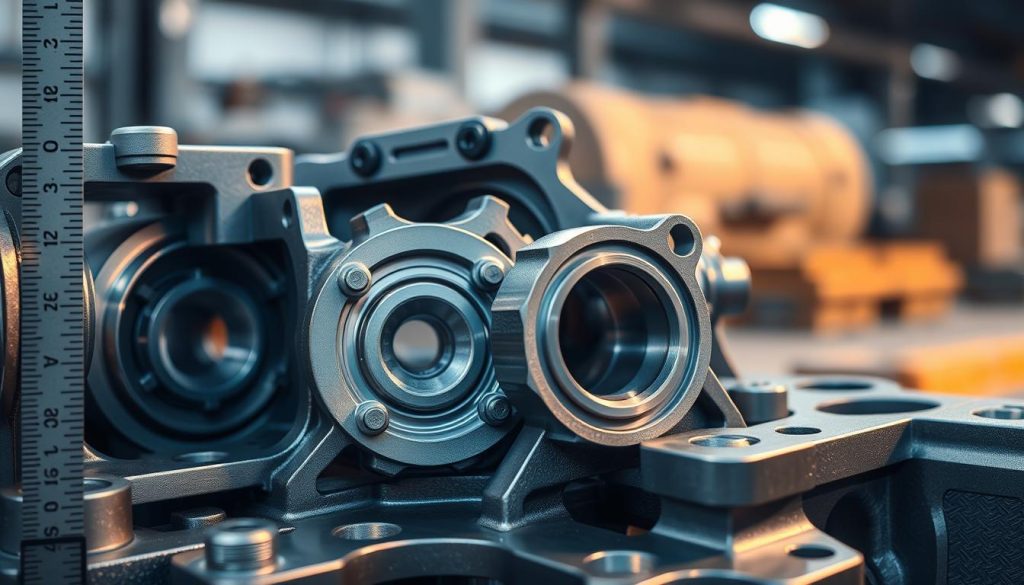
Cost-Effectiveness for Mass Production
Die casting is also very cost-effective for making lots of parts. Although it costs a lot to make the mold first, the process is quick and doesn’t need much labor. This makes it a smart choice for companies looking to save money and make parts efficiently.
“Die casting allows us to produce high-quality parts with complex shapes and tight tolerances at a fraction of the cost of other manufacturing methods. This has been a game-changer for our business.”
– Jane Doe, Manufacturing Manager at ABC Corporation
Applications of Die Casting
Die casting is key in many industries. It’s known for its versatility and top-notch performance. It’s used in cars, planes, gadgets, and more, thanks to its precision, strength, and cost savings.
Automotive and Aerospace Components
In cars, die casting makes engine parts, frames, and more. These parts are strong, reliable, and fit perfectly. In planes, it’s used for engine parts, landing gear, and more. This ensures safety and top performance.
Consumer Electronics and Industrial Parts
Die casting is big in making gadgets like phone frames and computer casings. It’s all about precision and durability. It’s also used for industrial parts, like tool housings and machine components. These parts need to be strong and cost-effective.
“Die casting has revolutionized the way we design and produce critical components across various industries, offering unparalleled precision, durability, and cost-effectiveness.”
Die casting is a go-to for many industries. It’s flexible and meets a wide range of needs. From cars and planes to gadgets and industrial parts, it’s essential.
Shixinproto’s Die Casting Services
Shixinproto is a top name in custom metal casting. They offer advanced die casting services for complex projects across many industries. With top-notch facilities, a skilled team, and a focus on quality, they aim to deliver outstanding results for every project.
High-Quality Die Casting for Complex Projects
Shixinproto excels in die casting thanks to their knowledge of the latest tech and best practices. They use advanced equipment and strict quality checks. This ensures they make precise components with great finishes, making them a top choice for custom die casting.
Why Shixinproto Stands Out in Metal Casting
Shixinproto’s dedication to excellence shows in everything they do. Their experienced team, along with their focus on rapid prototyping and quality control, means every project gets the best care. Clients can rely on Shixinproto for custom solutions that fit their needs and meet top industry standards.
